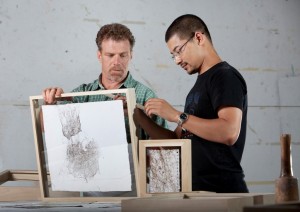
Jim Toia (left) works with Ritesh Maharjan '13 in the Williams Visual Arts Building.
Ritesh Maharjan ’13 (Kathmandu, Nepal) spent a good part of his summer designing and building a waterfall, picking mushrooms, framing drawings, figuring out the best way to get plants to grow from a giant wire grid on a brick wall, and researching irrigation systems.
The eclectic tasks, part of his collaborative work as an EXCEL Scholar with Jim Toia, director of Lafayette’s Community-Based Teaching program, weren’t exactly what he envisioned when he began his studies at Lafayette last year.
“Mechanical engineering seemed like the natural major for me in college,” says Majarjan, who has always enjoyed tinkering with remote-control miniature cars and other science- and engineering-related projects. “That is what I am good at and that is what I enjoy doing. But I recently discovered my passion for art.”
That passion, which Maharjan discovered in a drawing course last fall, led him to take another art course during the spring semester, to pursue a B.S. in mechanical engineering and an A.B. with a major in art, and to spend an adventurous summer working with Toia.
The results of Maharjan’s work include Toia’s Dissolving Gardens multi-media installation (including the waterfall) on display at Rutgers University’s Zimmerli Museum until Jan. 2, 2011, and his Islands (ant colonies, spores, webs, jellyfish & other natural phenomena) exhibition (including framed spider web and mushroom spore drawings) on display at the Kim Foster Gallery in New York City through this weekend.
A third exhibit, The Living Wall, to include a 40- by 60-foot wall that includes plants and houses for insects and bats, is still in progress and is scheduled for display at The Newark Museum during the summer of 2012.
Maharjan says that he was especially intrigued by how an art installation comes together.
“Jim basically buys most of his stuff himself, installs the art himself from scratch, and does all the work,” Mahajan says. “Somehow I did not picture an installation to be like that; I thought it would be more like other people doing the technical stuff for you. It was very exciting for me to witness.”
Toia, whose work nearly always focuses on nature and often incorporates natural objects, says he had never worked with an engineering student, but welcomed the opportunity.
“Sometimes, my installations are pretty elaborate,” he says, explaining that it’s helpful to work with a student who understands structure and also appreciates art. And, he adds, the experience gave Maharjan the opportunity to communicate with many different people in the art world.
“It’s such a holistic kind of moment, when so many different kinds of things come to the table,” Toia says, adding that he and Marjarjan have discussed working together again in 2011, when he plans to resume work on The Living Wall.
“His fresh perspective and intuition will certainly help,” Toia says.
Marharjan says his experience has increased his desire to incorporate art into his life.
“I love art, and would love to do that for a living,” he says. “I am not sure how the combination of art and engineering will work out for me yet, but that is not important, at least for now.”
